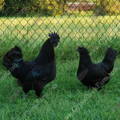
10 Interesting Facts About Ayam Cemani Chickens
From its distinctive all-black appearance to its historical role in ceremonial rituals, the ayam cemani stands apart from other poultry breeds for the role it has played in the rural villages and traditions of its’ home country. Let’s explore the captivating allure of the Ayam Cemani.
The ayam cemani is a domesticated breed that was developed over centuries on the island of Java for its' completely black and magical appearance.
Subscribe
To join our mailing list and never miss an update!
The ultra-rare ayam cemani chicken breed captivates enthusiasts worldwide with its mystique and allure. Discover more about this fascinating, and very expensive chickens’ origins, cultural significance, unique characteristics and breeder challenges.
From its distinctive all-black appearance to its historical role in ceremonial rituals, the ayam cemani stands apart from other poultry breeds for the role it has played in the rural villages and traditions of its’ home country. Let’s explore the captivating allure of the ayam cemani.
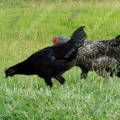
1. ORIGIN
The ayam cemani is a rare breed of chicken originating from Indonesia, specifically from the island of Java. They are particularly prevalent in the central and eastern regions of Java, where traditional breeding practices have been maintained for generations.
Ayam cemani are a domesticated breed. While they may share some genetic ancestry with jungle fowl, they have been selectively bred over generations for specific traits, including their unique all-black appearance. Ayam Cemani chickens are not found in the wild and are solely a domesticated poultry breed.
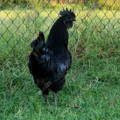
2. APPEARANCE
This breed is known for its unique and striking appearance, with entirely black feathers, skin, beak, comb, wattles, and even internal organs. This distinctive all-black coloration is due to hyperpigmentation, known as fibromelanosis, which causes the black coloration on both the inside and outside of the ayam cemani breed.
The ayam cemani is a smooth legged chicken with absolutely no feathers on the legs or feet. Contrary to internet rumors, the ayam cemani’s blood is not black and they do not lay black eggs.
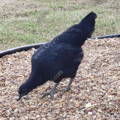
3. BREED VARIETIES
Ayam cemani are a standard size chicken breed and come in two common varieties: smooth feathered and hard feathered. "Hard feathered" refers to a specific type of feathering in poultry, particularly in chickens. Hard feathering describes feathers that are stiff, firm, and close-fitting to the bird's body. Birds with hard feathering typically have feathers that are strong and sturdy, with minimal fluffiness or softness.
Some ayam cemani breeders are developing a bottle brush feathered variety. “Bottle brush feathering is characterized by feathers that are stiff, upright, and closely packed, resembling the bristles of a bottle brush. This feathering pattern is similar to hard feathering but amplified further in its’ characteristics.
The only acceptable comb on the ayam cemani breed is a single comb with clearly defined points. And of course, the only color acceptable on the bird is black.
4. PURPOSE
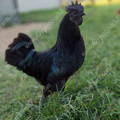
Trending Articles
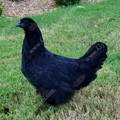
5. EGG PRODUCTION
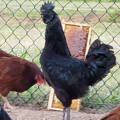
6. MEAT QUALITY
While Ayam cemani chickens are not typically raised for meat production due to their rarity and value, their meat is flavorful and considered a delicacy in some Indo-Asian regions.
The meat tastes like regular chicken meat, but it does have a dark gray/black appearance that some may find visually unappetizing. Ayam cemani meat is particularly tasty in Thai and Oriental dishes.
7. CLIMATE HARDINESS
Ayam cemani chickens are generally hardy and adaptable to various climates. Poultry enthusiasts keep ayam cemani in their flocks everywhere from the coldest parts of Canada to the most tropical regions of the world. As with all poultry, they do require adequate shelter and protection from extreme cold and windy weather conditions.
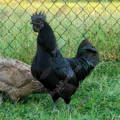
8. TEMPERAMENT
Ayam cemani are calm and docile, making them ideal for backyard or small-scale farming operations. Hens are broodier than other breeds and make very good mothers. The ayam cemani is not a heavy bird so they are able to fly over fencing that is 5 feet high, and this should be taken into consideration if you plan on keeping them in your backyard flock.
9. PRICE
Ayam cemani chickens are one of the most expensive chicken breeds in the world, with individual birds often commanding thousands of dollars. Reputable breeders will only sell all-black birds. Any mulberry coloration in the comb and/or wattles as well as any white flesh on the feet/toes is not a high-quality ayam cemani.
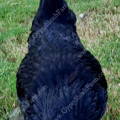
There should be absolutely no leakage in the feather coloration of a pure blood ayam cemani. Leakage is the term for any feathering on the bird that is a color other than black. It is common and acceptable for the ayam cemani feathers to have a blue, purple or greenish shimmer to their blackness, but any leakage of white is unacceptable.
10. POPULARITY
Despite their high price and rarity, ayam cemani chickens have gained popularity worldwide among poultry enthusiasts due to their unique appearance and cultural significance.
Breeders, particularly in America, find the ayam cemani to be a challenging breed to develop. This is largely due to the import restrictions on poultry into the U.S. and the limited availability of high-quality breeding stock in the country. It takes reputable breeders several years to develop their line and show out consistently. This too, makes the ayam cemani highly sought after by chicken keepers wanting to add these rare and unique specimens to their flock.
In conclusion, the ayam cemani is a rare and enigmatic breed of chicken. It has captivated poultry enthusiasts worldwide with its mystique and allure. Originating from the lush landscapes of Indonesia's Java Island, this breed stands out for its striking all-black appearance, encompassing feathers, skin, and even internal organs.
While steeped in traditional Javanese culture and folklore, the ayam cemani has transcended its ceremonial roots to become a symbol of prestige and admiration among breeders and collectors globally. Add one to your backyard chicken flock and enjoy this beautiful and captivating bird.
Trending Products
Copyright©2024 All rights reserved. We love to have you share our article as long as you include a direct link to this page. This article or any portion thereof , including all images, may not be reproduced or used in any manner whatsoever without the express written permission of Gypsy Shoals Farm.



